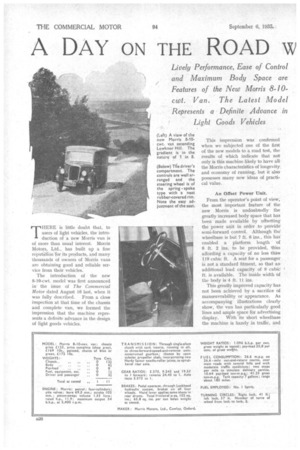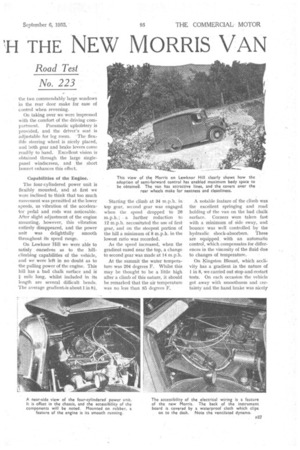A DAY ON THE ROAD vi H THE NEW MORRIS VAN
Page 40

Page 41

Page 42

If you've noticed an error in this article please click here to report it so we can fix it.
Lively Performance, Ease of Control and Maximum Body Space are Features of the New Morris 8-1 0cwt. Van. The Latest Model Represents a Definite Advance in Light Goods Vehicles
THERE is little doubt that, to users of light vehicles, the introduction of a new Morris van is of more than usual interest. Morris Motors, Ltd., has built up a fine rePUtatiOn for its products, and many thousands of owners of Morris vans are obtaining good and reliable service from their vehicles.
The introduction of the new 8-10-cwt. model was first announced in the issue of The Commercial Motor dated August 16 last, when it was fully described. From a close inspection at that time of the chassis and complete Van, we formed the impression that the machine represents a definite advance in the design of light goods vehicles.
This impression was confirmed when we subjected one of the first of the new models to a road test, the results of which indicate that not only is this machine likely to have all the Morris characteristics of longevity. and economy of running, but it also possesses many new ideas of practical value.
An Offset Power Unit.
From the operator's point of view; the most important feature of the new Morris is undoubtedly the greatly increased body space that has been made available by offsetting the power unit in order to provide' semi-forward control. Although the wheelbase is but 7 ft. 6 ins., this has' enabled a platform length " of 8 ft. 2 ins, to be provided, -dins affording a capacity of no less than 119 cubic ft. A seat for a passenger is not a standard fitment, so that an additional load capacity of 9 cubic ft. is available. The inside width of the body is 4 ft. 11 ins.
This greatly improved capacity has not been achieved by a sacrifice of manceuvrability or appearance. As accompanying illustrations clearly show, the van has particularly good lines and ample space for advertising display. With itsshort wheelbase the machine is handy in traffic, and the two commendably large windows in the rear door make for ease of control when reversing.
On taking over we were impressed with the comfort of the driving compartment. Pneumatic upholstery is provided, and the driver's seat is adjustable for leg room. The flexible steering wheel is nicely placed, and both gear and brake levers come readily to hand. Exec:Rent vision is obtained through the large singlepanel windscreen, and the short• bonnet enhances this effect.
Capabilities of the Engine.
The four-cylindered power unit is flexibly mounted, and at first we were inclined to think that too much movement was permitted at the lower speeds, as vibration of the accelerator pedal and rods was noticeable. After slight adjustment of the engine mounting, however, this vibration entirely disappeared, arid the power unit was delightfully smooth throughout its speed range.
On Lewknor Hill we were able to satisfy ourselves as to the hillclimbing capabilities of the vehicle, and we were left in no doubt as to the pulling power of the engine. This hill has a bad chalk surface and is a mile long, whilst included in its length are several difficult bends. The average gradient,is about 1 in 8.
Starting the climb at 34 m.p.h. in top gear, second gear was engaged when the speed dropped to 20 m.p.h.; a further reduction to 12 m.p.h. necessitated the use of first gear, and on the steepest portion of the hill a minimum of 8 m.p.h. in the lowest ratio was recorded.
As the speed increased, when the gradient eased near the top, a change to second gear was made at 14 m.p.h.
At the summit the water temperature was 204 degrees F. Whilst this may be thought to be a little high after a climb of this nature, it should be remarked that the air temperature was no less than 85 degrees F. A notable feature of the climb was the excellent springing and road. holding of the van on the bad chalk surface. Corners were taken fast with a minimum of side sway, and. bounce was well controlled by the hydraulic shock-absorbers. These are equipped, with an automatic control, which compensates for differences in the viscosity of the fluid due to changes of temperature.
On Kingston Blount, which acclivity has a gradient in the nature of 1 in 8, we carried out stop-and-restart tests. On each occasion the vehicle got away with smoothness and certainty and the hand brake was nicely positioned to enable this result to be achieved with ease on every occasion.
A good indication of the performance of the Morris van on main-road hills was shown by the easy manner in which it surmounted the wellknown Dashwood Hill, on the main London-Oxford road. This hill is over a mile long and has an average gradient of 1 in 18, the maximum being 1 in 10. Starting the climb at something over 30 m.p.h. in top gear, the speed never dropped below the thirty mark, and no change to a lower ratio was necessitated.
ailed Top-gear Performance.
Good acceleration is a feature of the new Morris, and an accompanying graph shows that 50 m.p.h. may be attained from rest in less than a minute. The top-gear performance is correspondingly good, but the easy gear change—with a synchromesh mechanism for top and second gears—encourages the use of the intermediate gear to enable the maximum benefit to be obtained from the high-revving characteristics of the engine.
Operated on the Lockheed hydraulic system, the foot brake gave smooth retardation without any tendency to lock the wheels. Good results were obtained from various speeds, and the pedal pressure required was commendably light.
The hand brake, which is intended to be used as a parking brake and operates on the rear wheels, proved capable of holding the vehicle with certainty on steep gradients. When used as a service brake a tendency to lock the rear wheels was apparent.
For our consumption test we covered a 26.6-mile out-and-return course from Highgate to Elstree, via Barnet. Two stops were made in each mile to simulate delivery conditions, and exactly one gallon of petrol was consumed. This figure of
26.6 m.p.g. should be a reliable guide to the consumption likely to be obtained under full-load conditions
with many stops, although there is little doubt that it might well be improved upon when the van is engaged on non-stop work.
A side-mounted petrol tank, having a capacity of 7 gallons, is provided.
A small point of criticism occurs to us in this connection, in that the filler spout is rather on the short. side, so that when the tank is full the fuel is apt to slop over on corners or when the vehicle is parked on a well cambered road.
Well-built Body.
The body is substantially built and well planned to provide easy loading, he platform height being but 1 ft. 11 ins. It is equipped with wide rear doors with large windows, above which are ventilating louvres. The problem of stowing the spare
wheel has been well tackled, and it is mounted on a ,concealed carrier below the body at the rear, being enclosed by a cover at the back, which incorporates the number plate.
Traffic indicators are fitted and are controlled by a neat switch in the centre of the steering wheel; a small warning light is embodied in the switch, which clearly shows when the indicators are in operation.
• A further feature of interest is the provision of detachable guards over the upper halves of the rear wheels on the outside. These snake for cleanliness" and 4re quickly removed when necessary. The wheel brace, which fits the nuts on the covers, is conveniently placed in clips below the driver's seat. For convenience of loading, the " wheel-arches are made with square tops..
Maximum Space for Pay-load.
The vehicle represents a good attempt .to make the utmost use of every available inch of space, and the design appears to have been carefully thought out from the utility point of view.
As previously mentioned, the results of our test confirmed the good impression formed on our first examination of the vehicle, and there is little doubt that this machine will make a' wide appeal to those who require speedy and reliable transport of loads up to 8-10 cwt.




























































































